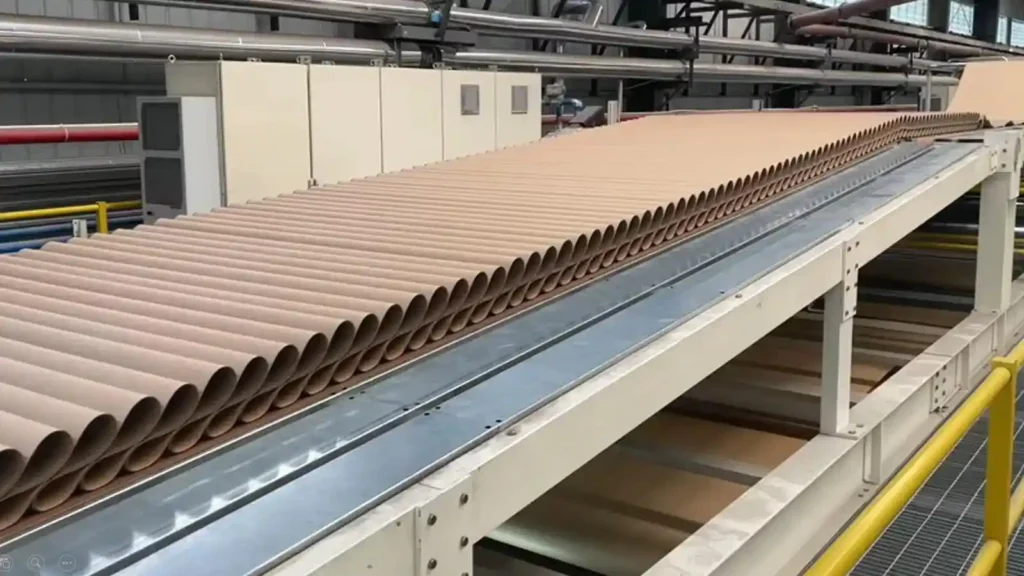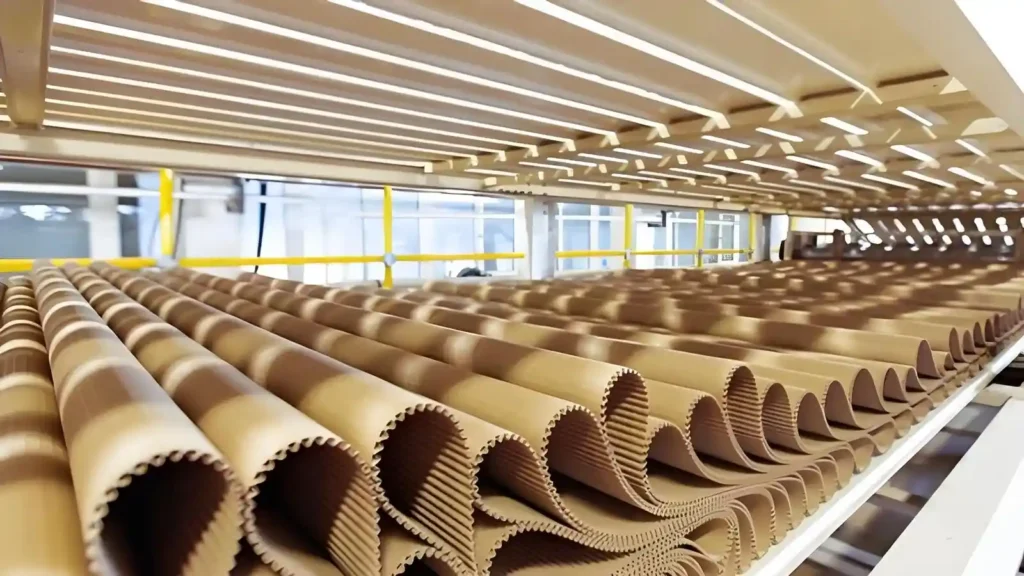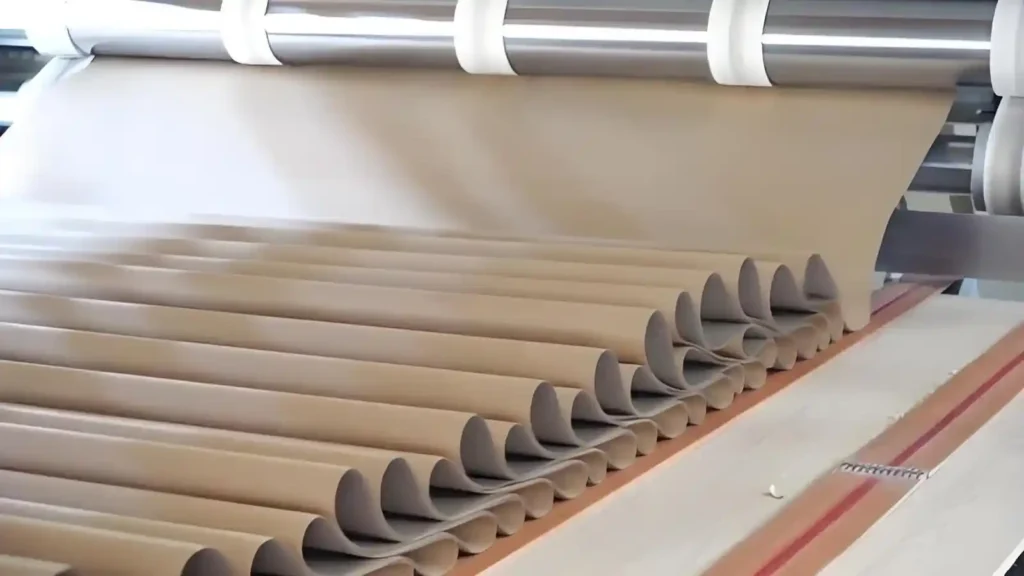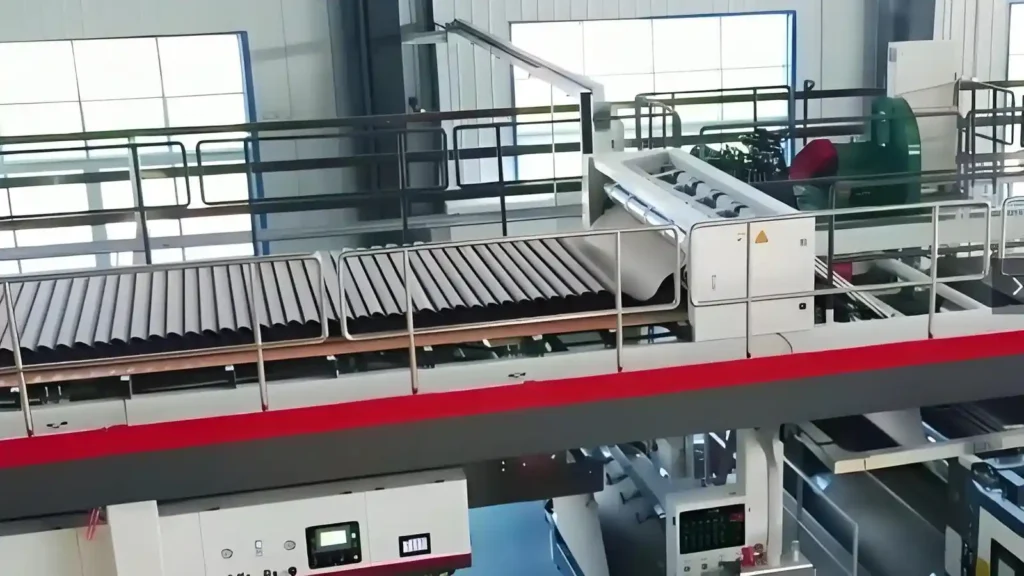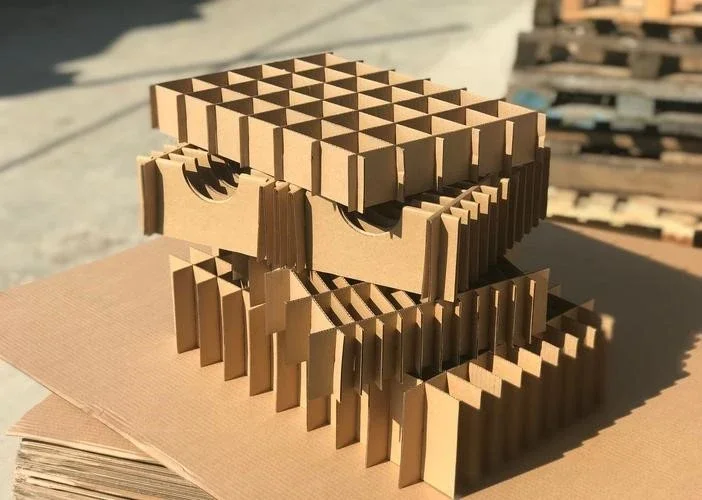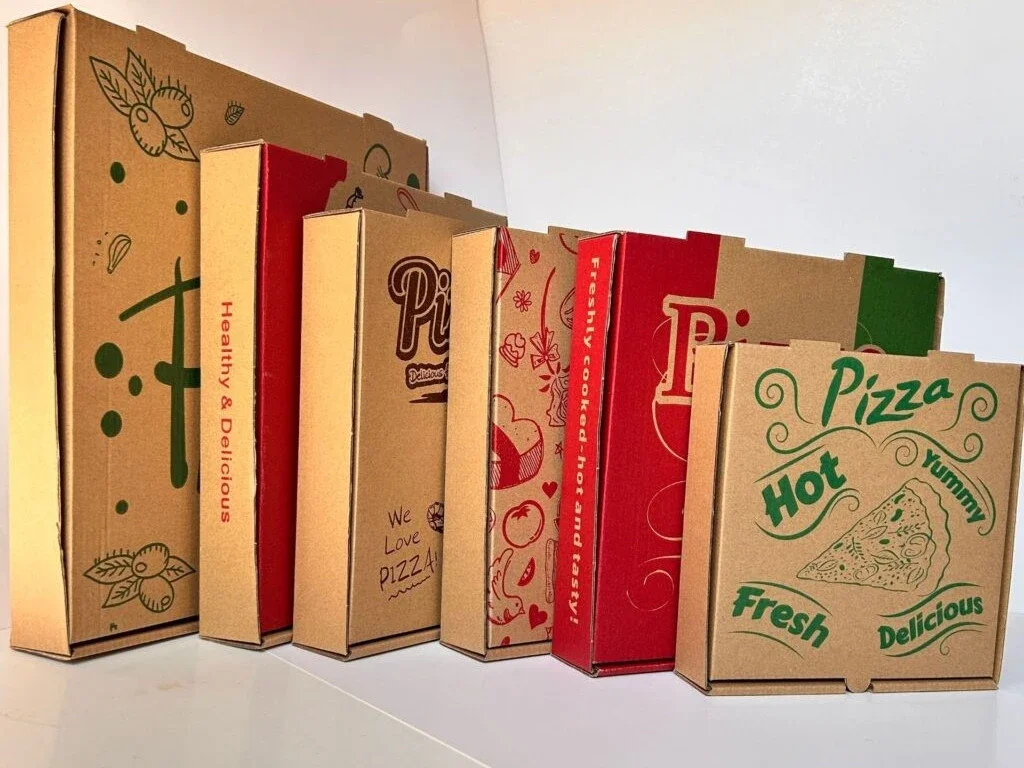——From Structure to Selection
1. What is an Overhead Conveyor Bridge in a Corrugated Cardboard Production Line?
An overhead conveyor bridge, often referred to as a “conveying bridge” or “cardboard transition bridge” in the industry, is a core conveying device connecting the single facer and double facer in a corrugated cardboard production line, serving as a vital overhead bridge above the production line.
Typically installed between the outlet of the single facer and the inlet of the double facer (2-4 meters above the ground, adjusted based on layout), its primary function is to receive single wall corrugated boards (e.g., C-flute or B-flute single-ply boards) produced by the single facer, convey them stably to the double facer, and resolve issues such as speed discrepancies between front and rear equipment, board misalignment, and tension fluctuations to ensure smooth production flow.
2. What Components Make Up an Overhead Conveyor Bridge?
We break down the core components of an overhead conveyor bridge into six key modules to clarify their functions:
| Component Name | Function Description |
| Conveying Mechanism | Drives corrugated boards forward via belts, chains, or rollers—the core power unit for transportation. |
| Frame Structure | A steel structure that supports the entire bridge, ensuring stability and rigidity during operation. |
| Web Guiding System | Uses photoelectric sensors to detect board position and mechanical pushers to realign lateral misalignment, ensuring precise conveying paths. |
| Tension Control Device | Adjusts board tightness via swing rollers and magnetic powder brakes to prevent wrinkling (from loose tension) or stretching (from excessive tension). |
| Accumulation Buffer Device | Temporarily stores boards to balance speed differences between upstream and downstream equipment, avoiding production halts due to mismatched speeds. |
| Control System | Centered on a PLC and touchscreen, it coordinates all components, allows parameter setting, and monitors equipment status in real time. |
3. How Does an Overhead Conveyor Bridge Work?
The workflow of an overhead conveyor bridge can be simplified into three stages: “receiving→adjusting→feeding”, each with thoughtful design:
3.1 Receiving: Accepting Single Wall Corrugated Boards
Single wall corrugated boards from the single facer enter the conveying mechanism via the bridge’s paper receiving roller. Belts or chains activate immediately to smoothly transfer the boards to the next stage.
3.2 Adjusting: Correcting Misalignment and Stabilizing Tension
- Web Guiding: If the board shifts laterally, photoelectric sensors detect the deviation and trigger pushers or air suction devices to realign the board to its preset path.
- Tension Control: If the board becomes loose (wrinkling) or tight (stretching), the swing roller mechanism adjusts the conveying angle, while the magnetic powder brake precisely controls resistance to maintain optimal tension.
3.3 Feeding: Buffering and Precise Transfer to the Double Facer
- Accumulation Buffering: The bridge’s mid-section S-shaped accumulation rack temporarily stores boards in a folded pattern, acting as an “elastic buffer.” When the single facer runs faster than the double facer, excess boards are stored to prevent line stoppages.
- Precise Feeding: Finally, boards pass through the bridge’s outlet synchronizing rollers and enter the double facer at a stable speed, providing a flat base for bonding with face paper.
4. Why is an Overhead Conveyor Bridge Necessary for Corrugated Production Lines?
Without an overhead conveyor bridge, corrugated production would face significant inefficiencies. Its role addresses three critical challenges:
4.1 Balancing Speed Differences to Avoid Downtime
Single facers and double facers often operate at different speeds (e.g., 100m/min for the single facer vs. 80m/min for the double facer). The bridge’s accumulation buffer acts as a “dynamic buffer zone,” storing excess boards to allow independent speed adjustment of both machines.
4.2 Ensuring Bonding Precision and Reducing Waste
Misaligned, wrinkled, or stretched boards entering the double facer can cause bonding defects like misalignment or bubbles, leading to waste. The bridge’s web guiding and tension control ensure boards remain straight and flat, significantly improving yield.
4.3 Boosting Line Efficiency and Reducing Labor
Without a bridge, manual board handling and adjustment are required, which is slow and error-prone. The bridge enables automated conveying and intelligent adjustment, allowing continuous production with only periodic inspections—improving efficiency by at least 30%.
5. What Are the Types of Overhead Conveyor Bridges?
Overhead conveyor bridges on the market are categorized based on “production line requirements (board layers, speed) + functional configuration”. Choosing the right type directly impacts performance:
5.1 Classified by Adapted Board Layers
| Type | Adapted Corrugated Board Type | Features | Application Scenarios |
| Single-layer Bridge | 3-ply corrugated board | Single-channel conveying; simple structure; cost-effective | Small factories/low-speed lines (≤80m/min) |
| Double-layer Bridge | 5-ply corrugated board | Dual-track synchronous conveying; standard web guiding | Medium factories/medium-speed lines (80~150m/min) |
| Triple-layer Bridge | 7-ply corrugated board | Triple-track precision synchronization; complex design; highly customized | Large factories/high-speed lines (≥150m/min) |
5.2 Classified by Functional Configuration
| Type | Core Functions | Configuration and Market Position |
| Basic Bridge | Only provides basic conveying; no web guiding or tension control. | Entry-level configuration; cost-focused for simple lines. |
| Web Guiding Bridge | Adds photoelectric web guiding to correct lateral misalignment in real time. | Upgraded with guiding; suitable for standard stable production. |
| Tension-Controlled Bridge | Integrates web guiding and tension adjustment to stabilize board tightness. | Dual-function; ensures flatness for mid-to-high-end lines. |
| Intelligent Buffer Bridge | Full integration + data networking + automatic speed difference matching; supports smart control. | High-end smart configuration; for high-speed, intelligent lines. |
5.3 Classified by Line Speed
- Low-speed bridges (≤80m/min): Mostly basic models, suitable for small lines with simple production needs.
- Medium-speed bridges (80~150m/min): Equipped with web guiding and tension control as standard, meeting most carton factories’ needs.
- High-speed bridges (≥150m/min): Must use intelligent buffer models to ensure stability (e.g., for 7-ply board production).
6. How to Select the Right Overhead Conveyor Bridge?
Follow these four steps to match the bridge to your production line needs:
6.1 Define Core Production Line Requirements
- Board layers: Choose single-layer for 3-ply, double-layer for 5-ply, triple-layer for 7-ply (mismatched layers will render the bridge unusable).
- Operating speed: Basic models for low-speed (≤80m/min), web guiding + tension control for medium-speed (80~150m/min), and intelligent buffer models for high-speed (≥150m/min).
6.2 Prioritize Key Functions
- Limited budget: Prioritize web guiding and tension control (critical for product quality; non-negotiable).
- Efficiency-focused: Add intelligent buffering and data networking (ideal for lines with frequent order changes).
6.3 Evaluate Manufacturer Capabilities
- Case studies: Request references for similar production lines (e.g., for 5-ply boards, ask for clients using double-layer bridges).
- After-sales support: Key components like web guiding sensors and magnetic powder brakes are wear parts. Confirm warranty periods and spare parts delivery times (critical for overseas clients).
6.4 Focus on Global Compatibility and Long-Term Value
- Brand and service network: Prefer brands with mature overseas service networks to ensure quick access to spare parts and technical support during breakdowns.
- Customization flexibility: Overseas lines often have unique regional standards or factory constraints. Confirm if the manufacturer supports customization of frame height, conveying width, and voltage specifications for seamless integration.
- Compatibility with international equipment: If integrating imported machinery (e.g., single facers, double facers), verify communication protocols and speed-matching capabilities to avoid system conflicts.
7. How to Maintain an Overhead Conveyor Bridge Daily?
Daily maintenance focuses on five key tasks to ensure stable operation and extend service life:
7.1 Daily Cleaning (Performed Daily)
- Use compressed air to blow away paper debris in roller and belt gaps (debris buildup causes slipping).
- Wipe photoelectric sensor lenses (dust interferes with guiding accuracy).
7.2 Lubrication (Performed Weekly)
- Apply specialized lubricating oil to chains and bearings (avoids board contamination and reduces wear).
- Check belt tension (normal deflection is ≤1cm when pressed; loose belts cause slipping).
7.3 Precision Calibration (Performed Monthly)
- Calibrate web guiding sensors: Align with a standard ruler to ensure “0 deviation” when boards are centered.
- Calibrate tension swing rollers: Manually pull boards to check for smooth movement (jamming disrupts tension control).
7.4 Replacement of Wear Parts (Every 6 Months to 1 Year)
- Replace worn belts and chains (replace when frayed or cracked to prevent breakage).
- Inspect magnetic powder brake pads (replace when thickness ≤2mm to maintain tension accuracy).
7.5 Climate-Specific Protection (Adjust by Region)
Climatic conditions vary globally, requiring targeted maintenance:
- Humid regions (e.g., Southeast Asia, South American rainforests): Install moisture-proof covers for motors and control boxes; use dehumidifiers to keep internal humidity ≤60% RH.
- Dry, dusty regions (e.g., Middle East, African deserts): Increase dust removal frequency; add dust covers for belts and sensors to prevent static and contamination.
- Regions with extreme temperature fluctuations (e.g., Northern Europe, Australia): Check frame fasteners regularly to avoid deformation from thermal expansion/contraction.
8. Common Faults and Solutions for Overhead Conveyor Bridges
Three frequent faults may occur during production; quick fixes can restore operation:
8.1 Fault 1: Severe Board Misalignment, Web Guiding Failure
- Causes: ① Dusty sensor lenses; ② Jammed guiding pushers; ③ Uneven belt tension.
- Solutions:
- Clean sensor lenses with alcohol-dampened tissue.
- Lubricate jammed pushers with WD-40 if manually movable.
- Adjust belt tensioners to balance tension on both sides.
8.2 Fault 2: Conveying Stalls, Abnormal Noise, or Board Stagnation
- Causes: ① Paper debris entangled in rollers; ② Chain derailment; ③ Motor overload (unstable voltage).
- Solutions:
- Stop the line and remove debris from roller gaps with tools (never use hands to avoid injury).
- Realign derailed chains with sprockets.
- Check motor voltage with a multimeter; contact electricians for voltage anomalies.
8.3 Fault 3: Fluctuating Tension, Board Wrinkling/Stretching
- Causes: ① Magnetic powder brake failure (coil burnout); ② Malfunctioning swing roller sensors; ③ Uneven raw paper thickness.
- Solutions:
- Replace with spare magnetic powder brakes (keep spares on hand).
- Recalibrate swing roller sensors to reset “zero point.”
- Temporarily reduce line speed or replace raw paper to eliminate material issues.
9. Trends in Overhead Conveyor Bridge Development
Future advancements in overhead conveyor bridges will focus on four directions to enhance corrugated production:
9.1 Intelligent Upgrades: From Semi-Automatic to Fully Smart
Bridges will integrate deeply with MES systems, automatically reading order data (e.g., switching to double-layer mode for 5-ply boards) and predicting bearing wear via vibration sensors for fault pre-warning.
9.2 Energy Efficiency Optimization: Higher Efficiency, Greener Operation
Adopting servo motors and energy-saving algorithms instead of traditional asynchronous motors will reduce energy consumption by over 30%. Accumulation racks will feature “low-resistance S-shapes” to minimize board damage.
9.3 Modular Design: Flexible Upgrades Like “Lego”
Manufacturers will offer “function modules”: Basic bridges can be retrofitted with guiding or tension modules later, avoiding full replacement and lowering upgrade costs.
9.4 Customization for Special Lines
Bridges will be tailored for extra-wide boards (≥2.5m) and ultra-thin flutes (E, F flutes), with softer conveying belts and precise tension control.
10. Why Choose Jeytop’s Overhead Conveyor Bridges?
Jeytop Carton Machinery is rooted in China’s core corrugated machinery industrial cluster, leveraging local full-industry-chain resources for efficient collaboration. This not only ensures equipment quality and cost-effectiveness but also shortens the production cycle of overhead conveyor bridges by 15-20% compared to the industry average, getting high-adaptability equipment into production faster.
Jeytop’s overhead conveyor bridges cover all scenarios: Intelligent buffer models suit high-speed lines, improving conveying stability and reducing waste; customized models handle harsh environments like high dust or humidity; basic models optimize tension control to reduce waste for small-to-medium lines. All models feature precise operation systems, with high-end versions offering intelligent speed synchronization, zone-specific adaptive tension, and optional remote diagnostics—ensuring continuous production, multi-flute compatibility, and quick issue response.
For special needs, we provide tailored solutions: Roller preheating components for low-temperature regions to prevent board brittleness; moisture-proof control boxes for high-humidity areas; ultra-wide channels for wide-format lines—solving scenario-specific challenges.
With 15 years in the industry, Jeytop is a national high-tech enterprise with CE and ISO9001 certifications, serving 3,000+ carton factories globally across 20+ sectors. We offer end-to-end concierge service from selection consulting and cross-border logistics to overseas installation, commissioning, and operator training.
If you need a high-stability overhead conveyor bridge solution for your production line, contact our technical team. Jeytop will customize a plan based on your capacity, board type, and regional climate—ensuring efficient, precise conveying for every meter of board.
Connect with Us
🌐 Visit our website: [jeytop.com]
📧 Email: [jeytopmachinery@163.com]
📱 WhatsApp:[wa.me/]

